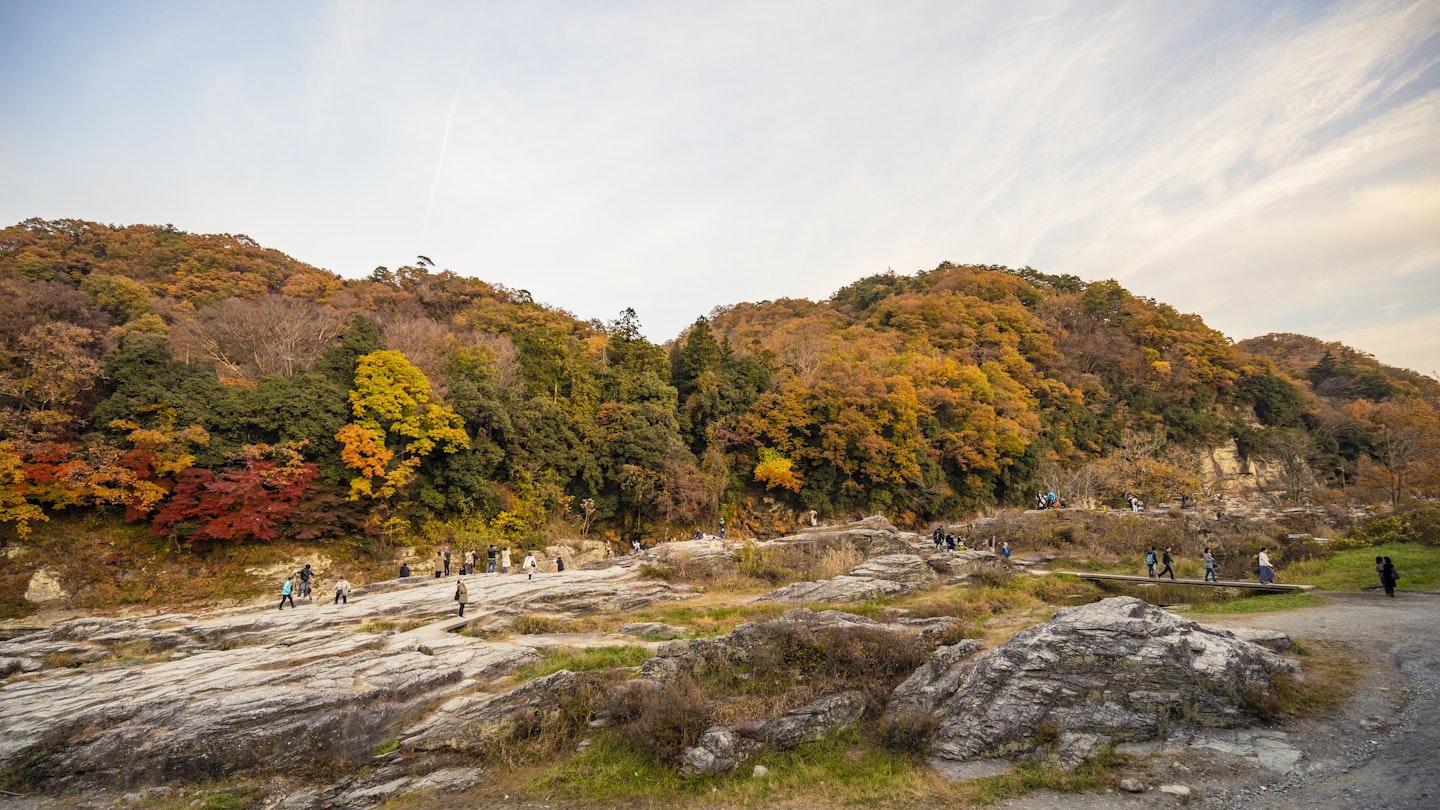If you envision Tokyo as an eye, then Saitama Prefecture acts as the eyebrow curling around the city from the northeast to the northwest. The eastern parts, located near the capital, are bustling with countless train lines carrying commuters into Tokyo for daily activities, while the western parts feature forest-covered mountains, tea fields, rice paddies, and orchards.

Escape to the Countryside
For any traveler overwhelmed by the sensory overload of Tokyo, Saitama Prefecture offers low-key, off-the-beaten-path cultural experiences, allowing you to discover the authentic Japan away from the increasing influx of visitors in Tokyo.
This region is ideal for indulging in hands-on learning about washi paper-making techniques, designing a ceramic teacup while enjoying Japanese tea and conversing with the instructor, or studying the art of bonsai (the cultivation of miniature trees) at the Omiya Bonsai Art Museum. Participate in a rattan weaving workshop to handcraft your own original pair of coasters, or make your own Japanese doll in Iwatsuki, known as ‘the town of dolls.’ These experiences not only allow you to learn about Japanese art from the masters but also enable you to create unique mementos to take home.

Discover the Many Delights of Chichibu
A must-see experience in Saitama Prefecture is the small town of Chichibu, renowned throughout Japan for the Chichibu Sanjūyon-kasho, a 34-temple Buddhist pilgrimage covering 100 kilometers that dates back to the early 13th century. These temples honor Kannon, the deity of compassion and mercy, and all have free admission, making them easy to visit.
Chichibu also offers excellent hiking in the surrounding mountains, particularly around Mitsumine-jinja, an atmospheric Shinto shrine at the summit of the mountain of the same name. The Chichibu mountains are known for their mineral-rich water, perfect for sake production. Matsuoka Brewery, established in 1851, produces award-winning sake with a fruity aroma and a unique mild taste. Additionally, Matsuoka offers citrus and chocolate-flavored brews that are great gifts. Be sure to take some Daiginjō sake home to savor; it has topped the National Sake Competition eight times. Due to its popularity, reserve your spot for free English-language tours in advance.

While exploring this delightful region, consider staying at Miyamotoke Ryokan, a traditional Japanese inn. The current owner, Kazuteru Miyamoto, is the twelfth generation of the Miyamoto family to manage the ryokan and a former sumo wrestler. Experience the hospitality that features tatami-mat rooms, an onsen (hot spring bath), and fresh farm-to-table meals.
If you plan to visit in December, the Chichibu Night Festival offers a fantastic escape from the winter chill. The historic Chichibu Yomatsuri is one of Japan’s Three Great Float Festivals. Marvel at two festooned kasaboko (massive parasol-like objects) and two yatai (house-shaped floats) paraded through the illuminated city streets, especially exciting on December 3rd, as the massive floats, weighing up to 20 tonnes, are carried up steep slopes amidst drumming and flute music, coupled with enthusiastic cheers from the crowd. Fireworks add to the spectacle, lighting up the night sky.

Step Back in Time in Kawagoe
East of Chichibu, and just an hour by train from Tokyo station, lies the charming town of Kawagoe. Its main street is lined with kurazukuri, clay-walled warehouse buildings reminiscent of the Edo Period (1603-1867). Known as ‘Little Edo,’ Kawagoe features a beautiful 16m-high wooden bell tower that chimes four times daily. Additionally, Kita-in, a Buddhist temple, offers a unique experience with its 500 rakan. These lifelike statues represent disciples of Buddha who attained enlightenment and were carved in stone between 1782 and 1825. Each statue has its unique facial features and personality. Legend has it that everyone has a lookalike among the 500, making it a fun quest to find yours.

Hit a Home Run in Tokorozawa
In addition to its rich cultural offerings, Saitama Prefecture is an excellent destination for sports fans. Just 20 minutes by train from Tokyo’s Ikebukuro Station, Tokorozawa shines especially during baseball season. Its stadium, the Seibu Dome, is home to the Saitama Seibu Lions, a popular and successful professional baseball team owned by the Seibu Group, which also operates department stores, hotels, and railway lines. Attending a game is more than just watching baseball; fans actively participate in coordinated chants and support songs that enhance the experience. While in Tokorozawa, aviation enthusiasts should visit the Tokorozawa Aviation Museum, located at Japan’s first airfield, established in 1911.
Although most Japanese tea is cultivated in the southern and western regions, **Sayama-cha** (Sayama tea), grown near Tokorozawa, is celebrated as one of Japan’s finest green teas, alongside Shizuoka-cha and Uji-cha. Tea lovers can explore various farm tea shops independently or join a tour. If you find yourself in Japan during late April, don’t miss the Tokorozawa Tea Festival. Visitors can also enjoy berry picking and shiitake mushroom hunting at Sayama Berryland, one of Japan’s largest blueberry and strawberry farms.
While Saitama Prefecture may not offer iconic attractions like DisneySea, Tokyo Skytree, or Shibuya’s scramble crossing, it possesses a wealth of opportunities for those in search of genuine Japanese experiences that are often overlooked by foreigners. Therefore, taking the time to explore nearby Saitama Prefecture is sure to enrich your travel experience.
Produced by GoTravelDaily for the Saitama Prefectural Government Department of Industry and Labor Tourism Division. All editorial views are those of GoTravelDaily alone and reflect our policy of editorial independence and impartiality.





